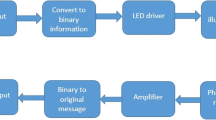Abstract
In this paper, first, visible light communications system and corresponding wireless channel with related random variables are reviewed. Then, considering channel random variables, important communication performance, i.e., average channel capacity and channel outage probability are calculated. Finally, to evaluate the obtained results, numerical calculations are provided.








Similar content being viewed by others
References
Pathak, P. H., Feng, X., Hu, P., & Mohapatra, P. (2015). Visible light communication, networking, and sensing: A survey, potential and challenges. IEEE Communications Surveys & Tutorials, 17(4), 2047–2077.
Lian, J., et al. (2019). Indoor visible light communications, networking, and applications. Journal of Physics: Photonics, 1(1), 012001.
Wyszecki, G., & Stiles, W. (2000, August). Color science: Concepts and methods, quantitative data and formulae. Wiley classics library.
IEEE Standard for Local and Metropolitan Area Networks--Part 15.7: Short-Range Wireless Optical Communication Using Visible Light. IEEE Std 802.15.7-2011, pp. 1–309, 2011.
Rodríguez, J., et al. (2018). Efficient visible light communication transmitters based on switching-mode dc-dc converters. Sensors, 18(4), 1127.
Dixit, V., & Kumar, A. (2020). Performance analysis of indoor visible light communication system with angle diversity transmitter. In 2020 IEEE 4th Conference on Information & Communication Technology (CICT). IEEE.
Memedi, A., & Dressler, F. (2020). Vehicular visible light communications: A survey. IEEE Communications Surveys & Tutorials, 23(1), 161–181.
Aboagye, S., et al. (2021). Intelligent reflecting surface-aided indoor visible light communication systems. IEEE Communications Letters, 25(12), 3913–3917.
Dowhuszko, A. A., et al. (2021). Effect of the color temperature of LED lighting on the sensing ability of visible light communications. In 2021 IEEE International Conference on Communications Workshops (ICC Workshops). IEEE.
Schneider, D., et al. (2021). Impact of industrial environments on visible light communication. Optics Express, 29(11), 16087–16104.
Zukauskas, A., Shur, M. S., & Gaska, R. (2002). Introduction to solid-state lighting. John Wiley & Sons.
Komine, T., & Nakagawa, M. (2004). Fundamental analysis for visible-light communication system using LED lights. IEEE transactions on Consumer Electronics, 50(1), 100–107.
Vappangi, S., & Mani, V. V. (2022). A survey on the integration of visible light communication with power line communication: Conception, applications and research challenges. Optik, 266, 169582.
Cui, K., Chen, G., Xu, Z., & Roberts, R. D. (2010). Line-of-sight visible light communication system design and demonstration. In Communication Systems Networks and Digital Signal Processing (CSNDSP), 2010 7th International Symposium on (pp. 621–625). IEEE.
Poulis, S.-I., et al. (2022). Effective current pre-amplifiers for Visible Light Communication (VLC) receivers. Technologies, 10(1), 36.
Zaeer Dhaam, H., et al. (2021). Performance of high scalability hybrid system of 10G-TDM-OCDMA-PON based on 2D-SWZCC code. Journal of Optical Communications.
Qiu, Y., Chen, H. H., & Meng, W. X. (2016). Channel modeling for visible light communications—A survey. Wireless Communications and Mobile Computing, 16(14), 2016–2034.
Kahn, J. M., & Barry, J. R. (1997). Wireless infrared communications. Proceeding of the IEEE, 85(2), 265–298.
Aboagye, S., et al. (2022). RIS-assisted visible light communication systems: A tutorial. IEEE Communications Surveys & Tutorials.
Jiang, X., & Zhu, N. (2010, September). Analysis of power request and multiple-site techniques for indoor wireless visiblelight communication system using LED lights. In 2010 6th International Conference on Wireless Communications Networking and Mobile Computing (WiCOM), Chengdu, pp. 1–4.
Abed, N. H., AL-Dujaili, M., & Abbas, S. A. (2022). Proposed an efficient multilevel dynamic bandwidth allocation (M-DBA) scheme for FiWi networks. Optical and Quantum Electronics, 54(10), 615.
Komine, T., et al. (2009). Adaptive equalization system for visible light wireless communication utilizing multiple white LED lighting equipment. IEEE Transactions on Wireless Communications, 8(6), 2892–2900.
Funding
The author(s) received no financial support for the research, authorship, and/or publication of this article.
Author information
Authors and Affiliations
Corresponding author
Ethics declarations
Conflicts of Interest
We have no conflicts of interest to disclose.
Availability of Data and Material
Not available.
Code Availability
Not available.
Additional information
Publisher's Note
Springer Nature remains neutral with regard to jurisdictional claims in published maps and institutional affiliations.
Rights and permissions
Springer Nature or its licensor (e.g. a society or other partner) holds exclusive rights to this article under a publishing agreement with the author(s) or other rightsholder(s); author self-archiving of the accepted manuscript version of this article is solely governed by the terms of such publishing agreement and applicable law.
About this article
Cite this article
Shamsah, M.A., Al-Khazraji, M.J.AD. & Hodtani, G.A. Capacity and Achievable Rate Analysis for Visible Light Communication Channels. Wireless Pers Commun 133, 2003–2017 (2023). https://doi.org/10.1007/s11277-023-10843-0
Accepted:
Published:
Issue Date:
DOI: https://doi.org/10.1007/s11277-023-10843-0




